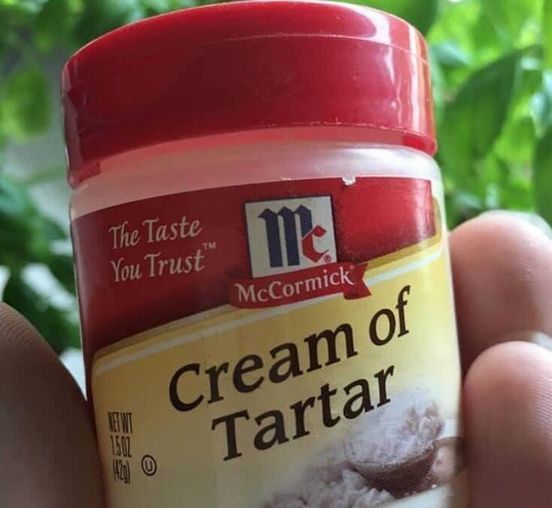
Cream of what now?
Cream of tartar is one of those mystery ingredients you might have seen in your grandma's pantry without knowing what it's used for. After all, its name doesn't give you a clue—not like baking powder or baking soda. Yet just a touch of it makes a big difference in your baking and cooking. Here's what it is and how to use it in recipes, and even around the house.
What is cream of tartar?
First of all, it's not creamy. It's a dry, powdery, acidic byproduct of fermenting grapes into wine. Its sciency name is potassium bitartrate, aka potassium hydrogen tartrate or tartaric acid (hence the commercial name). But you can find it in the spice aisle labeled as plain ol' cream of tartar. It is a byproduct of the wine making process.
What is cream of tartar used for?
Adding a small amount of cream of tartar when you're beating egg whites—usually 1/8 teaspoon per egg white—speeds up the creation of foam and helps stabilize the structure of those miniscule air bubbles you're whipping up. In baking, this means mile-high meringue pies, melt-in-your-mouth meringue cookies, and angel food cakes that practically float off the plate.
Why is cream of tartar in snickerdoodle cookies?
It's what separates a tangy, chewy snickerdoodle from an ordinary cinnamon-coated sugar cookie. The acid in cream of tartar gives snickerdoodles their distinctive tangy flavor, and the chew happens because cream of tartar prevents sugar in the cookie dough from crystalizing into crunchiness. Science!
How else is cream of tartar used in recipes?
When combined with baking soda, it becomes a leavening agent (the stuff that makes baked goods puff up in the oven) by producing carbon dioxide gas. If you ever run out of baking powder, you can substitute 1/4 teaspoon baking soda plus 1/2 teaspoon cream of tartar for 1 teaspoon baking powder.
Add a pinch of cream of tartar to boiling vegetables to help them retain their bright, fresh color.
A pinch of cream of tartar also helps stabilize whipped cream to prevent it from deflating.
Make colorful, edible play dough!
What can I substitute for cream of tartar?
Use 2 teaspoons lemon juice or vinegar to create the acidic effect of 1 teaspoon of cream of tartar in a recipe.
What is cream of tartar's shelf-life?
Cream of tartar keeps its freshness indefinitely, as long as you store it in a cool, dry spot. When in doubt, you can test it by looking at it and smelling it. It should look white and powdery, and it should smell mildly acidic.
How else is it used around the house?
Cream of tartar makes an effective non-toxic household cleaner all by itself or combined with other earth-friendly kitchen ingredients such as lemon juice or vinegar. Try these ideas:
Metal polish: Add water to make a paste to polish stainless steel and aluminum. This also removes scratches on white bowls and plates caused by knives and forks.
Copper polish: Add lemon juice in a 1:1 mixture. Rub on, rinse off.
Porcelain sink, tub, toilet scrub: Add distilled white vinegar in a 1:1 solution.
All-purpose scrub: Add distilled white vinegar in a 4:1 solution (i.e., 1 cup vinegar to 1/4 cup cream of tartar). This also cleans stainless steel sinks like nobody's business.
Original Origin Unknown





